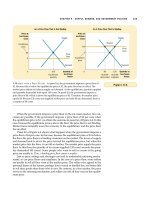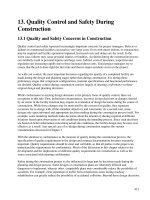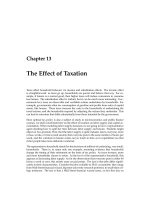micro economics chapter 13
Bạn đang xem bản rút gọn của tài liệu. Xem và tải ngay bản đầy đủ của tài liệu tại đây (114.84 KB, 16 trang )
13
Monopolistic Competition
and Oligopoly
McGraw-Hill/Irwin
Copyright © 2012 by The McGraw-Hill Companies, Inc. All rights reserved.
•
•
LO1
Monopolistic Competition
Relatively large number of sellers
• Small market shares
• No collusion
• Independent action
• Some control over price
Differentiated products
• Product attributes
• Service, location
• Brand-names, packaging
Monopolistic Competition
• Easy entry and exit
• Advertising
• Nonprice competition
LO1
Price and Output in Monopolistic
Comp
• Demand is more elastic than pure
•
LO2
monopoly because there are more
rivals and substitutes
Demand is less elastic than pure
competition because there are fewer
rivals and imperfect substitutes
Monopolistic Competition:
Efficiency
• Inefficient
• Productive inefficiency
• P > ATC
• Allocative inefficiency
• P > MC
LO2
Oligopoly
• A few large producers
• Homogeneous or differentiated
•
•
•
LO3
products
Limited control over price
• Mutual interdependence
• Strategic behavior
Entry barriers
Mergers
Oligopolistic Industries
• Four-firm concentration ratio
• 40% or more to be oligopoly
• Shortcomings
• Localized markets
• Inter-industry competition
• World price
• Dominant firms – Herfindahl Index
LO3
High Concentration Industries
(1)
Industry
Primary copper
(2)
4-Firm
Concentration
Ratio
(3)
Herfindahl
Index
99
ND
(1)
Industry
(2)
4-Firm
Concentration
Ratio
(3)
Herfindahl
Index
Petrochemicals
85
2662
83
1901
Cane sugar refining
99
ND
Small arms
ammunition
Cigarettes
95
ND
Motor vehicles
81
2321
80
2515
Household laundry
equipment
93
ND
Men’s slacks and
jeans
Beer
91
ND
Aircraft
81
ND
Electric light bulbs
89
2582
Breakfast cereals
78
2521
78
2096
Glass containers
88
2582
Household vacuum
cleaners
Turbines and
generators
88
ND
Phosphate fertilizers
78
1853
Tires
77
1807
Electronic
computers
76
Alcohol distilleries
71
Household
refrigerators and
freezers
85
1986
Primary aluminum
85
ND
LO1
2662
1609
3 Oligopoly Models
• Kinked Demand Curve
• Collusive Pricing
• Price Leadership
• Reasons for 3 models
• Diversity of oligopolies
• Complications of interdependence
LO5
Kinked Demand Curve
• Criticisms
• Explains inflexibility, not price
• Prices are not that rigid
• Price wars
LO6
Overt Collusion
• Collusion reduces uncertainty,
•
•
LO6
improves control of price, profits rise,
and prevents entry of firms
Cartels - a group of firms or nations
that collude
• Formally written agreement
• Sets output levels and price for
members
OPEC
Covert Collusion
• Gentleman’s agreements
• Informal understandings often in
social settings between firms about
price and output
LO6
Obstacles to Collusion
• Demand and cost differences
• Number of firms
• Cheating
• Recession
• New entrants
• Legal obstacles
• Golden Balls
LO6
Global Perspective
LO6
Price Leadership Model
• Price Leadership
• Dominant firm initiates price
•
•
LO6
changes
• Communicates price change
• Other firms follow the leader
Use limit pricing to block entry of new
firms
Possible price war
Oligopoly and Efficiency
• Oligopolies are inefficient
• Productively inefficient P > minATC
• Allocatively inefficient P > MC
• Qualifications
• Increased foreign competition
• Limit pricing
• Technological advance
LO7









